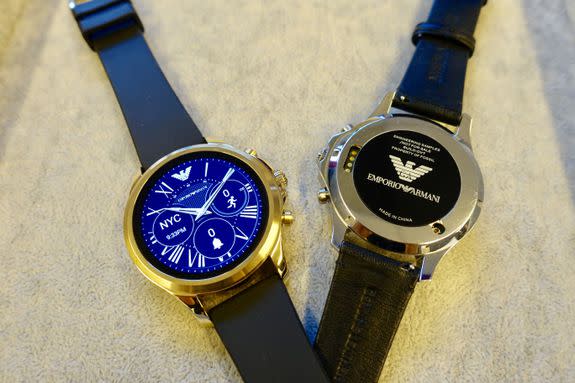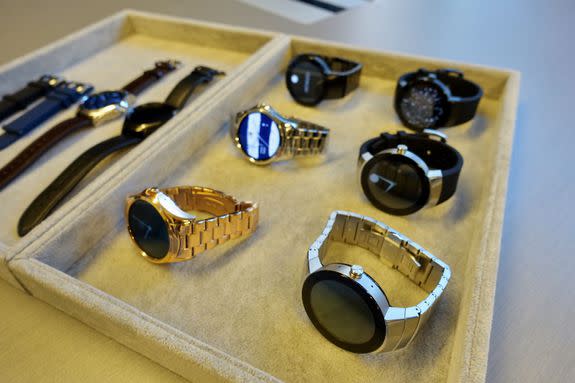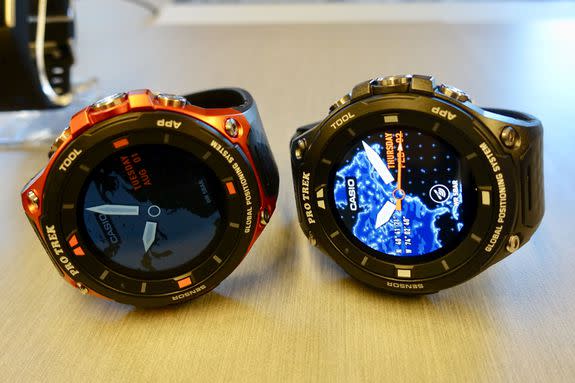How fashion brands are saving Android Wear smartwatches

Google's Android Wear smartwatch platform isn't dead. It's just pivoting from a do-everything experience on your wrist to one that's better customized for your own fashion and lifestyle.
That's good because I don't want a world where the Apple Watch is the only smartwatch that matters. It'd be too dystopian.
SEE ALSO: Everything we know so far about Google's Pixel 2
No matter how much you might adore your Apple Watch, the Samsung Gear S3 or LG Watch Style smartwatches can be described in a single word: disappointing.
The smartwatch market declined by 51.6 percent in Q3 of last year, resulting in a year-over-year drop in volume, according to IDC. The only one reportedly thriving is Apple Watch. But still, as a product category smartwatches simply haven't lived up to expectations.
Tech companies are giving up
Tech titans that were first to champion Android Wear and challenge the Apple Watch have largely given up on making smartwatches.
Motorola and Huawei both announced they have no plans to release new models soon. Huawei's CEO Eric Xu Zhijun said in April that smartwatches are essentially pointless. "I am always confused as to what smartwatches are for when we have smartphones." This is the company that released the Huawei Watch, the first promising and fashion-oriented Android Wear smartwatch.
Asus, one of the last of the well-known consumer electronics companies that supported Android Wear, is reportedly planning to axe its ZenWatch smartwatches altogether.
And Samsung hasn't supported Android Wear since its one-off Gear Live in 2014, instead choosing to iterate on its Tizen-based Gear S smartwatches.
LG's the only one that's still batting for Android Wear, but it can't save it. The company's Watch Sport and Watch Style released last year haven't moved the needle at all.
With everyone tossing in the towel, you'd be forgiven for thinking smartwatches are over.
Hitting the reset button

Image: RAYMOND WONG/MASHABLE
Waning interest means it's the perfect time to try again.
Android Wear will get better — 2.0 brings some useful updates — to its software, but having a variety of smartwatches is also key.
"It's a platform we're very committed to and investing in and the rest of Google is as well," David Singleton, Vice President of Android Engineering, told me.
"This is a pretty important and in some ways a potential breakthrough year because we're seeing more sticky experiences than we would have seen years ago. We're definitely seeing the number of people purchasing devices in the category has grown very significantly, but then we look at what people are actually doing with them — are they still active with them several months down the line? — we've seen that change positively pretty significantly as well so we're excited about that."
While most of its consumer tech friends have turned their back on the platform, Google's not worried at all because it's got new buddies that are keeping the flame alive: fashion brands.
In the last year, fashion labels have gone crazy with their Android Wear offerings. Brand names like Fossil, Michael Kors, Tommy Hilfiger, Hugo Boss, Emporio Armani, Guess, Diesel, and even Movado have embraced Android Wear. They're flooding the market with dozens of styles and sizes to cater to their fashion-conscious customers, and it's working. People are buying them. And they've got even more smartwatches in every size imaginable coming out this summer and fall.
Fashion first, tech second

Image: raymond wong/mashable
The Android Wear team seems to have figured out why the platform wasn't taking off: they weren't paying attention to why people wear watches in the first place.
Whether it's got a processor in it or not, a wrist-worn accessory needs to be stylish first and tech second.
"One of the big things for Fossil Group is that we take this fashion-first approach. We don't really say design is a second thought and tech comes first," says Hannah Liu, Director of Wearables Strategy and Strategic Partnerships at Fossil Group. Like other fashion labels, the brand's got a handful of Android Wear-powered smartwatches like the Fossil Q series. "For us, we've flipped that model where we're saying we'll never compromise on design and style because we know that's why customers buy our products and what kinda differentiates us from others.
"Android Wear 2.0 allows us to have these limitless options of what our customers care about. We did a study of our own — consumers trust in the tech because of a name like Google and Android and they know that it's a good platform — but what was really important to them was style and brand. Those were the two biggest purchase drivers."
Choice is arguably the most attractive thing about Android Wear compared to an Apple Watch. Sure, you can customize the Apple Watch by swapping out different bands, but you're still stuck with the square screen and limited watch faces. Like the hundreds of Android phones to pick from, Android Wear offers variety.
"That's why our play is actually going style first. You pick on style, you pick on some brands you love, and so the choices aren't as overwhelming because you're able to cut through all the diversity pretty quickly," Liu says.
I got to take a look at dozens of fashion-first smartwatches from Michael Kors, Fossil, Tommy Hilfiger, Movado, and more, and the sheer amount of choice is dizzying, but in a good way. Android Wear is not one size fits all and that's great for people who like to express themselves through what they wear.
Being true to the brand
"You have to make it familiar," a Michael Kors spokesperson told me. "For Michael Kors and Fossil Group, all of our smartwatches are based off of existing models that have been in the line for years and are tried and true styles that either have been constant or have stayed in the line and have evolved since then."
Style is important, but so too is the smartwatch software experience. Android Wear hardware has always come in all shapes and sizes, but the software has mostly been the same across the board to the point where it felt generic.
And that's where fashion brands are also mixing things up. Their smartwatches still run Android 2.0, but they're adding watch faces and features that are true to the brand and why people love them.
To drive home how rich some of the customizations are on some of these new smartwatches, Singleton walked me through how Michael Kors was differentiating their smartwatches from others.
For example, on a Kors smartwatch, you can not only manually switch watch faces, but also set it to change at different times. If you're, say, at work, it might show a watch face with complications like your calendar, email, or maybe a currency exchange rate. Once the clock hits a certain time (like 6 p.m.) it'll automatically change the watch face to another one, maybe one with fitness-tracking as you prepare to hit the gym after work. There's also another cool feature that matches your watch face to your outfit colors.
Movado is another luxury watch brand that's making sure its Connected smartwatch lives up to its heritage.
"There's a particular watch face dial that was designed by one of the Movado designers all the way back in the '40s, where there's a combination of a digital read-out for the hour as well as the minute, with a moving dot for the dial," Singleton says.
"The designers came up with this idea all the way back in the '40s but they couldn't execute it mechanically, so for Movado — with the expressivity of a digital canvas — they've been able to go back to their heritage of the brand and really look at things they wished they could have done before and then make them come to life in a smartwatch."
Perhaps, the nicest-looking and feeling new Android Wear smartwatch I got to check out was the Montblanc Summit. At $890, it's extremely pricey for an wearable that'll be obsolete in a few years, but, man, does it feel like a real watch. It's got a sapphire glass that curves at the case and touching it doesn't feel like touching a smartphone screen.
"They really understood their customer is someone who travels a lot and travels for business, but when they get there they want to work out and wanna be able to track the intensity of the workout with the heart-rate sensor," Singleton says.
People are embracing big smartwatches

Image: RAYMOND WONG/MASHABLE
As I briefly touched and tried on some of the smartwatches from the various brands, I noticed a common trend: they're all on the big side.
When the first smartwatches came out, the chief criticism from devices like the Moto 360 and LG G Watch R was that they were too big, bulky, and as a result uncomfortable to wear. Since then we've seen smartwatches slim down.
Now they're bulking back up again, but why? Didn't the fashion world get the memo that nobody wants a big smartwatch?
They're aware of these complaints and they don't care because big regular watches have always been in style. For example, Michael Kors' normal watches have always been chunky and that has never hurt sales.
"Having a bit of heft is actually something that is quite common in fashion and luxury watches to really give it a sense of feeling of wearing a watch," Singleton says. "It's great to be able to bring that to the smartwatch space as well. But we're also seeing significantly smaller watches this year as technology continues to mature. It's definitely going in both directions. I think diversity is good from that perspective."
Still an accessory for your phone

Image: RAYMOND WONG/MASHABLE
Before I finished grilling Singleton, I asked him the question that's probably on everyone's mind: Are smartwatches with built-in cellular connections dead?
He said that's not the case, but they're not a priority right now. "It's absolutely something we continue to invest in for the platform. Today, adding cell capabilities to a watch means that you have some huge tradeoffs in terms of size (like where you'd put the antennas)."
Singleton says he thinks cell-connected smartwatches will have more momentum in a few years and blamed the slow adoption on them needing their own phone numbers.
"We think that the ideal experience for a watch that can connect to cellular internet that works is that it can share your phone number with your phone, so that you don't have to think that your watch has a different phone number."
In the U.S., Verizon, AT&T and T-Mobile have services that allow you to sync up your phone's number so that you don't need a separate one for your smartwatch, but that's not really the case in other parts of the world.
"When you think internationally, there's still a lot of places where it's not possible today," Singleton says. "We're very much invested in making that future happen, together with some of those carriers and our OEM partners. We'll all invest together in miniaturizing some of the technology [when single phone number-syncing services arrive globally]."
Android Wear rises again

Image: RAYMOND WONG/MASHABLE
It's all too easy to declare smartwatches dead. The reality is they're not going anywhere, especially not when so many fashion brands are pumping out Android Wear smartwatches in myriad styles at varying price points.
While the majority of Android Wear smartwatches you'll see are from fashion labels, there are others like Tag Heuer, Casio, Polar and others who are finding their own niche. Smartwatches like the Casio Protrek which has custom features to help you fish better have passionate users who want a more digitally connected experience, and companies that offer those specialized experiences are flocking to deliver them in a wearable.
The tent poles of Android Wear will always be the apps and how they can show you the right information at the right time, and fitness-tracking. But
"Across the portfolio, I think various partners have really leaned into 'What do our customers want to do specifically with the watch?' and looked at pre-installing those kinds of experiences," Singleton says.
Fashion, however, is what'll drive Android Wear growth the most he says. It's hard not to see truth in that when there there are 20+ smartwatches running Google's wearable OS available to pick from. The big Android phone makers make up only tiny percentage of that.
"We ultimately do have that conviction that in order to be successful in wearable products long term, it's really important that people can choose products that fit their sense of style and the image they want to present to people through what it is they happen to be wearing on their wrist as well as benefitting from the tech features."
Android Wear's got a tall mountain to climb, but if Android's success is anything to go by, Google's still in the smartwatch game, and it could really turn Android Wear into a serious platform so long as its new fashion friends don't screw up.
WATCH: These interchangeable slip-on shoes can match any outfit


